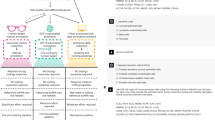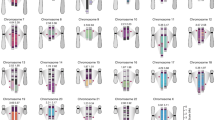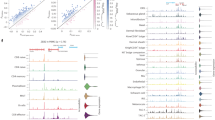Abstract
To uncover the function of and interplay between the mammalian cytosine modifications 5-methylcytosine (5mC) and 5-hydroxymethylcytosine (5hmC), new techniques and advances in current technology are needed. To this end, we have developed oxidative bisulfite sequencing (oxBS-seq), which can quantitatively locate 5mC and 5hmC marks at single-base resolution in genomic DNA. In bisulfite sequencing (BS-seq), both 5mC and 5hmC are read as cytosines and thus cannot be discriminated; however, in oxBS-seq, specific oxidation of 5hmC to 5-formylcytosine (5fC) and conversion of the newly formed 5fC to uracil (under bisulfite conditions) means that 5hmC can be discriminated from 5mC. A positive readout of actual 5mC is gained from a single oxBS-seq run, and 5hmC levels are inferred by comparison with a BS-seq run. Here we describe an optimized second-generation protocol that can be completed in 2 d.
This is a preview of subscription content, access via your institution
Access options
Subscribe to this journal
Receive 12 print issues and online access
$259.00 per year
only $21.58 per issue
Buy this article
- Purchase on Springer Link
- Instant access to full article PDF
Prices may be subject to local taxes which are calculated during checkout




Similar content being viewed by others
References
Deaton, A.M. & Bird, A. CpG islands and the regulation of transcription. Genes Dev. 25, 1010–1022 (2011).
Jones, P.A. Functions of DNA methylation: islands, start sites, gene bodies and beyond. Nat. Rev. Genet. 13, 484–492 (2012).
Feinberg, A.P. & Tycko, B. The history of cancer epigenetics. Nat. Rev. Cancer 4, 143–153 (2004).
Kriaucionis, S. & Heintz, N. The nuclear DNA base 5-hydroxymethylcytosine is present in Purkinje neurons and the brain. Science 324, 929–930 (2009).
Tahiliani, M. et al. Conversion of 5-methylcytosine to 5-hydroxymethylcytosine in mammalian DNA by MLL partner TET1. Science 324, 930–935 (2009).
Ito, S. et al. Tet proteins can convert 5-methylcytosine to 5-formylcytosine and 5-carboxylcytosine. Science 333, 1300–1303 (2011).
Globisch, D. et al. Tissue distribution of 5-hydroxymethylcytosine and search for active demethylation intermediates. PLoS ONE 5, e15367 (2010).
Munzel, M. et al. Quantification of the sixth DNA base hydroxymethylcytosine in the brain. Angew. Chem. Int. Ed. 49, 5375–5377 (2010).
Branco, M.R., Ficz, G. & Reik, W. Uncovering the role of 5-hydroxymethylcytosine in the epigenome. Nat. Rev. Genet. 13, 7–13 (2012).
Pfaffeneder, T. et al. The discovery of 5-formylcytosine in embryonic stem cell DNA. Angew. Chem. Int. Ed. Engl. 50, 7008–7012 (2011).
He, Y.F. et al. Tet-mediated formation of 5-carboxylcytosine and its excision by TDG in mammalian DNA. Science 333, 1303–1307 (2011).
Maiti, A. & Drohat, A.C. Thymine DNA glycosylase can rapidly excise 5-formylcytosine and 5-carboxylcytosine: potential implications for active demethylation of CpG sites. J. Biol. Chem. 286, 35334–35338 (2011).
Zhang, L. et al. Thymine DNA glycosylase specifically recognizes 5-carboxylcytosine-modified DNA. Nat. Chem. Biol. 8, 328–330 (2012).
Booth, M.J. et al. Quantitative sequencing of 5-methylcytosine and 5-hydroxymethylcytosine at single-base resolution. Science 336, 934–937 (2012).
Frommer, M. et al. A genomic sequencing protocol that yields a positive display of 5-methylcytosine residues in individual DNA strands. Proc. Natl. Acad. Sci. USA 89, 1827–1831 (1992).
Hayatsu, H. & Shiragami, M. Reaction of bisulfite with the 5-hydroxymethyl group in pyrimidines and in phage DNAs. Biochemistry 18, 632–637 (1979).
Huang, Y. et al. The behaviour of 5-hydroxymethylcytosine in bisulfite sequencing. PLoS ONE 5, e8888 (2010).
Meissner, A. et al. Reduced representation bisulfite sequencing for comparative high-resolution DNA methylation analysis. Nucleic Acids Res. 33, 5868–5877 (2005).
Yu, M. et al. Base-resolution analysis of 5-hydroxymethylcytosine in the mammalian genome. Cell 149, 1368–1380 (2012).
Ficz, G. et al. Dynamic regulation of 5-hydroxymethylcytosine in mouse ES cells and during differentiation. Nature 473, 398–402 (2011).
Pastor, W.A. et al. Genome-wide mapping of 5-hydroxymethylcytosine in embryonic stem cells. Nature 473, 394–397 (2011).
Sun, Z. et al. High-resolution enzymatic mapping of genomic 5-hydroxymethylcytosine in mouse embryonic stem cells. Cell Rep. 3, 567–576 (2013).
Yu, M. et al. Tet-assisted bisulfite sequencing of 5-hydroxymethylcytosine. Nat. Protoc. 7, 2159–2170 (2012).
Flusberg, B.A. et al. Direct detection of DNA methylation during single-molecule, real-time sequencing. Nat. Methods 7, 461–465 (2010).
Song, C.X. et al. Sensitive and specific single-molecule sequencing of 5-hydroxymethylcytosine. Nat. Methods 9, 75–77 (2011).
Wallace, E.V. et al. Identification of epigenetic DNA modifications with a protein nanopore. Chem. Commun. 46, 8195–8197 (2010).
Krueger, F. & Andrews, S.R. Bismark: a flexible aligner and methylation caller for bisulfite-seq applications. Bioinformatics 27, 1571–1572 (2011).
Quinlivan, E.P. & Gregory, J.F. III DNA digestion to deoxyribonucleoside: a simplified one-step procedure. Anal. Biochem. 373, 383–385 (2008).
Acknowledgements
We thank the UK Biotechnology and Biological Sciences Research Council for funding this work. S.B. and W.R. are recipients of Wellcome Trust Senior Investigator Awards. CEGX is a Syncona Partners–funded company.
Author information
Authors and Affiliations
Contributions
M.J.B. and S.B. invented the oxBS-seq method. M.J.B. and T.W.B.O. designed the experiments with contributions from all authors. M.J.B., T.W.B.O. and N.M.B. prepared samples and conducted experimental work. D.B. performed data analysis, interpretation and simulations. M.J.B. and T.W.B.O. drafted the manuscript and all authors contributed to writing, reviewing and editing the manuscript.
Corresponding author
Ethics declarations
Competing interests
T.W.B.O. is an employee of Cambridge Epigenetix, Ltd. M.J.B., N.M.B., D.B. and W.R. are consultants for Cambridge Epigenetix, Ltd. M.J.B., T.W.B.O., M.R.B., W.R. and S.B. are shareholders in Cambridge Epigenetix, Ltd. S.B. is an advisor to and shareholder of Illumina, Inc.
Supplementary information
Supplementary Figure 1
Identification via sequencing of uracil resulting from reacting 5fC from different sources with bisulfite. (PDF 461 kb)
Supplementary Figure 2
HPLC chromatogram of a digested, 5hmC-containing oligonucleotide before and after oxidation. (PDF 386 kb)
Supplementary Figure 3
Color changes of the oxidant solution. (PDF 270 kb)
Supplementary Figure 4
Agilent TapeStation analysis of 100mer digestion control with and without Taq1 digestion. (PDF 117 kb)
Supplementary Table 1
Fisher's test of varying sequence coverage. (PDF 168 kb)
Supplementary Table 2
Sequences of control DNA oligonucleotides. (PDF 357 kb)
Rights and permissions
About this article
Cite this article
Booth, M., Ost, T., Beraldi, D. et al. Oxidative bisulfite sequencing of 5-methylcytosine and 5-hydroxymethylcytosine. Nat Protoc 8, 1841–1851 (2013). https://doi.org/10.1038/nprot.2013.115
Published:
Issue Date:
DOI: https://doi.org/10.1038/nprot.2013.115
This article is cited by
-
The Fe–S cluster assembly protein IscU2 increases α-ketoglutarate catabolism and DNA 5mC to promote tumor growth
Cell Discovery (2023)
-
Profiling the epigenetic landscape of the antigen receptor repertoire: the missing epi-immunogenomics data
Nature Methods (2023)
-
Simultaneous sequencing of genetic and epigenetic bases in DNA
Nature Biotechnology (2023)
-
Dementia with Lewy bodies post-mortem brains reveal differentially methylated CpG sites with biomarker potential
Communications Biology (2022)
Comments
By submitting a comment you agree to abide by our Terms and Community Guidelines. If you find something abusive or that does not comply with our terms or guidelines please flag it as inappropriate.



